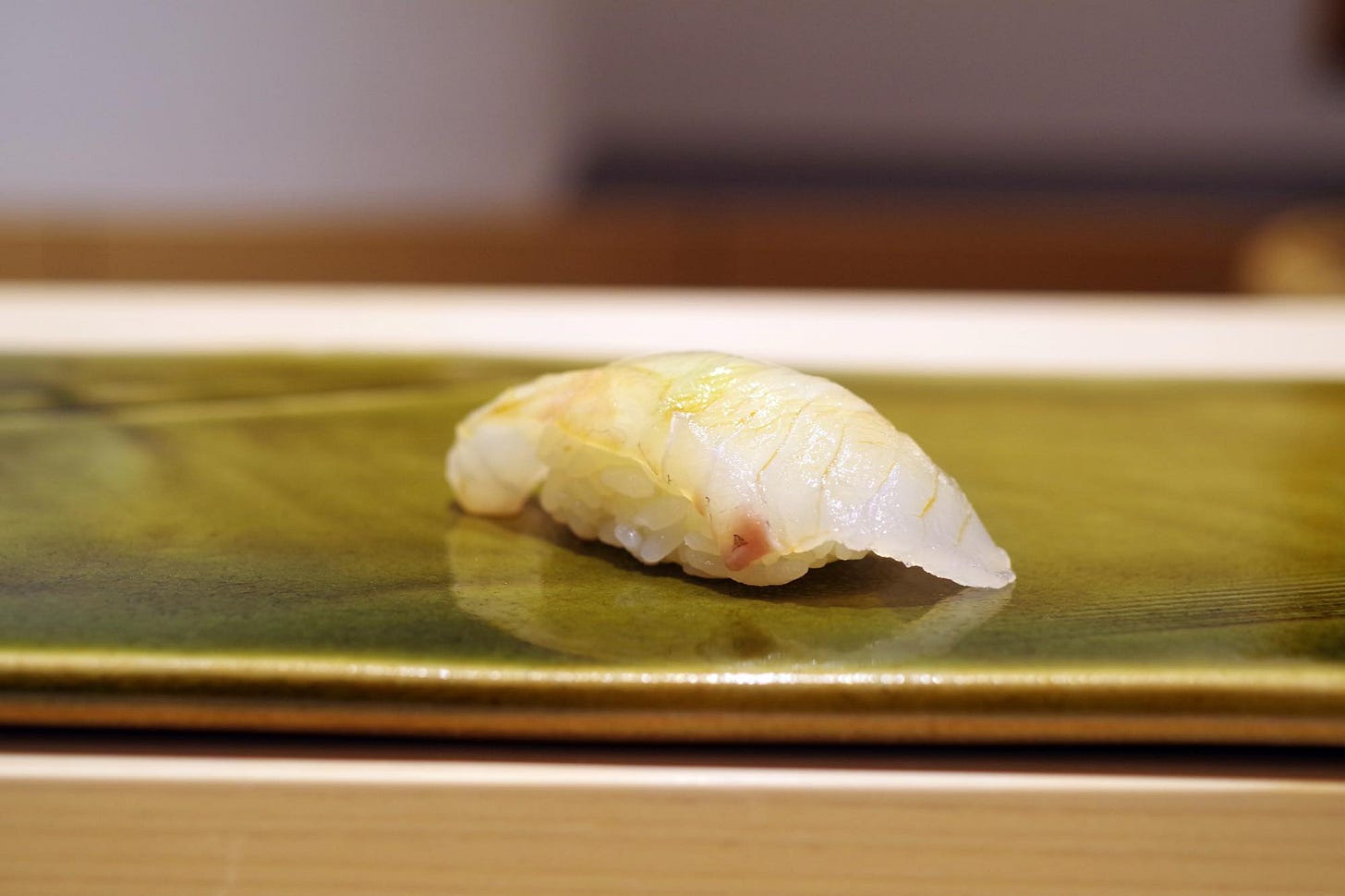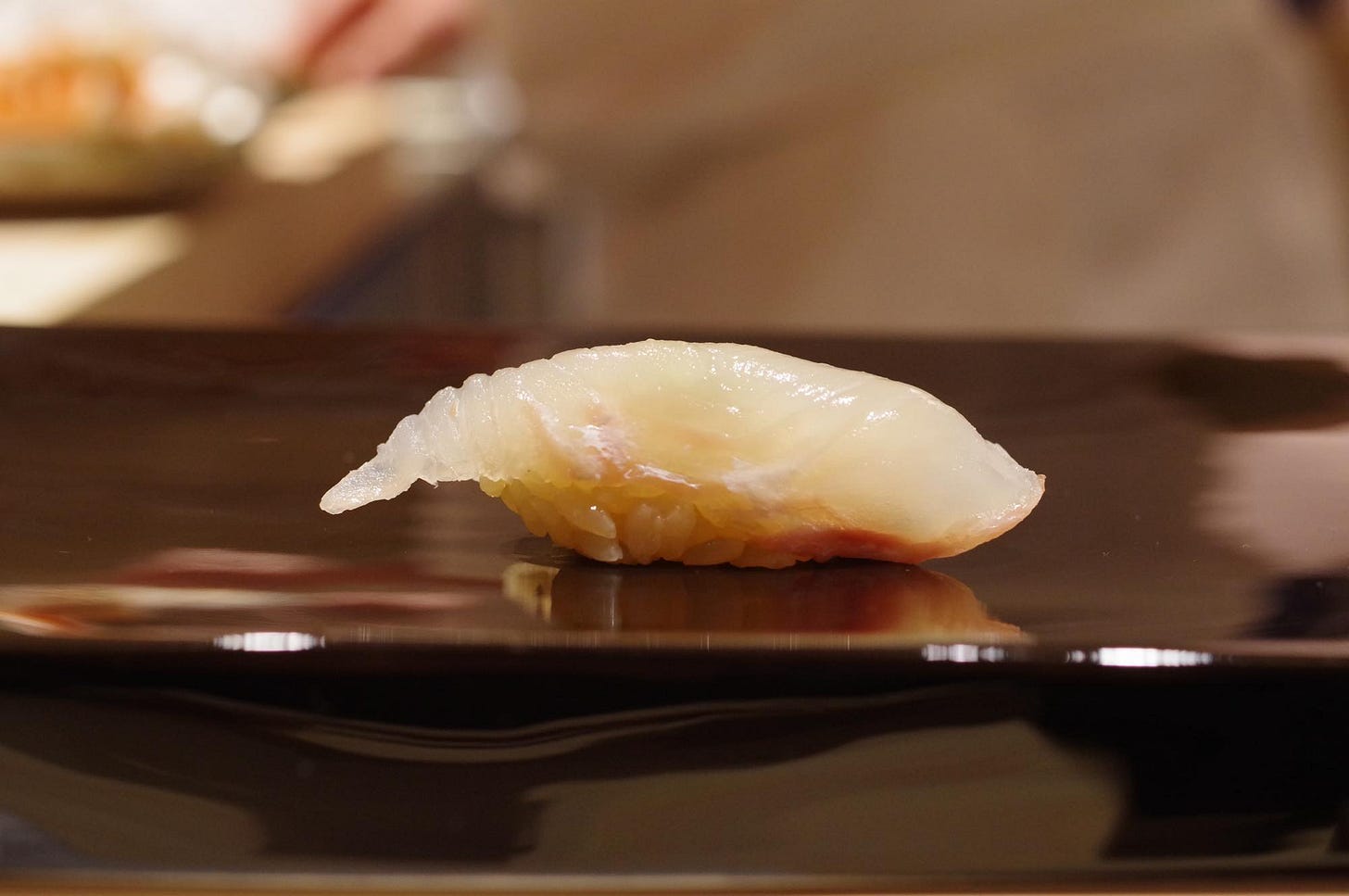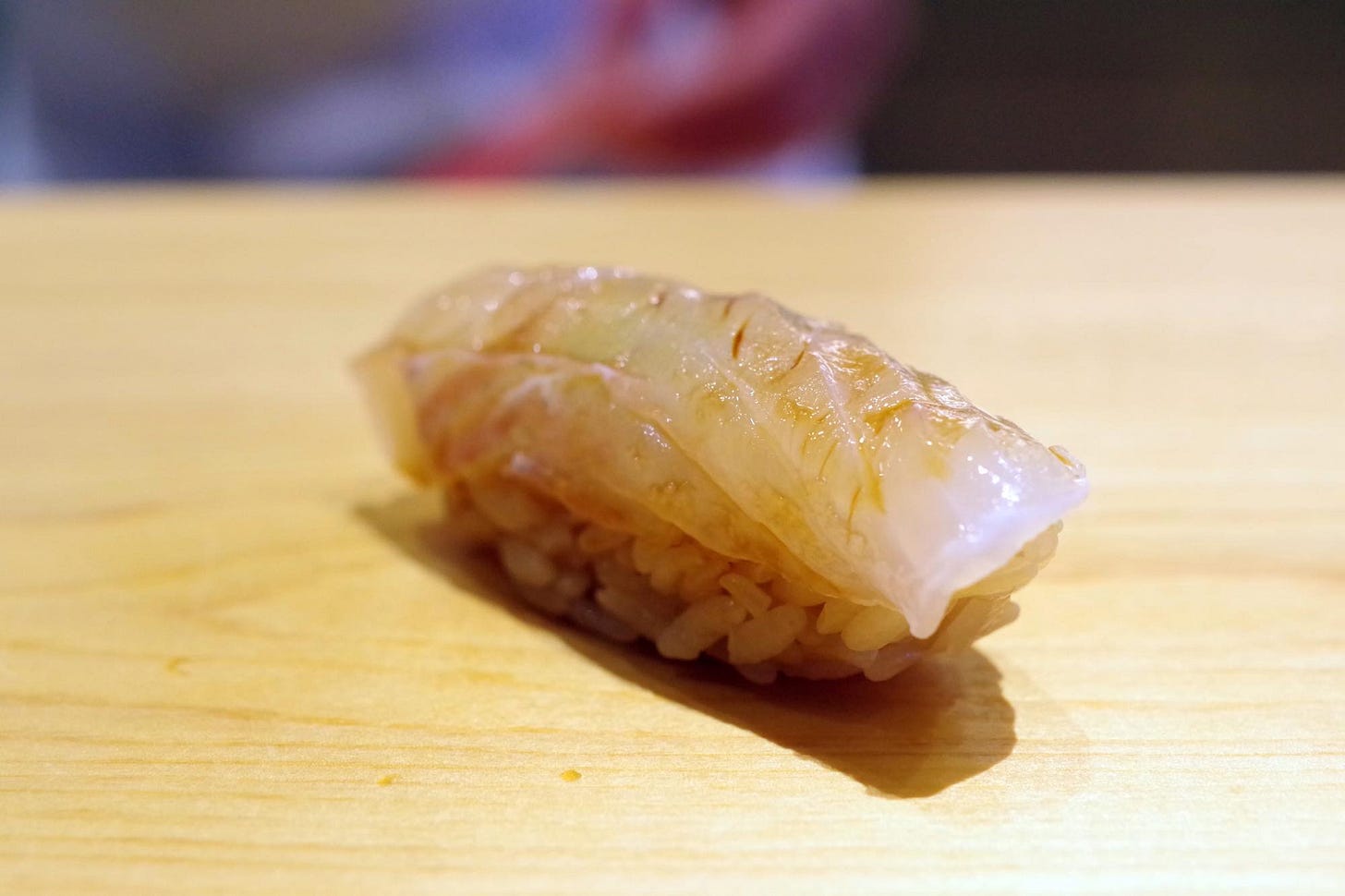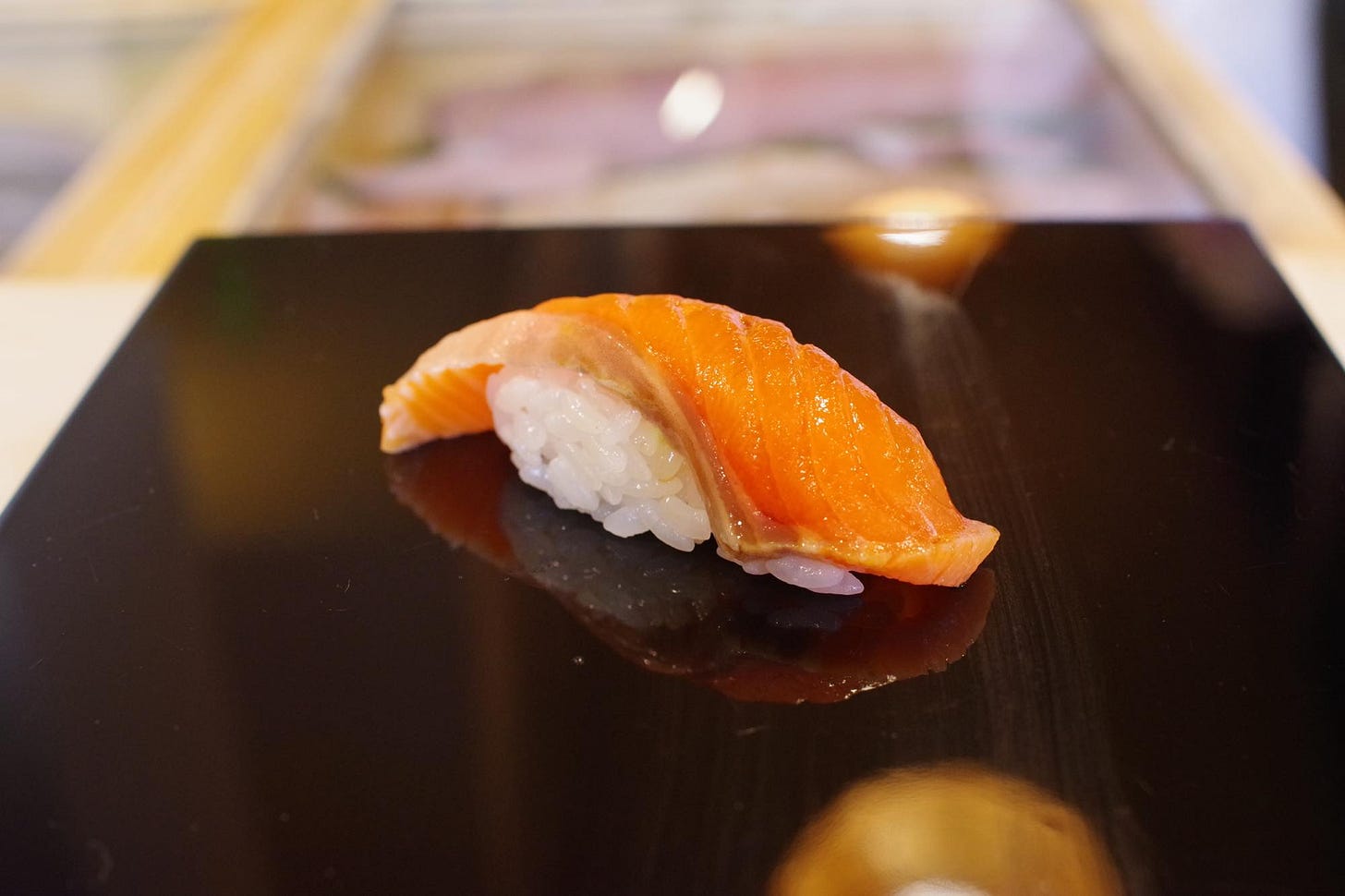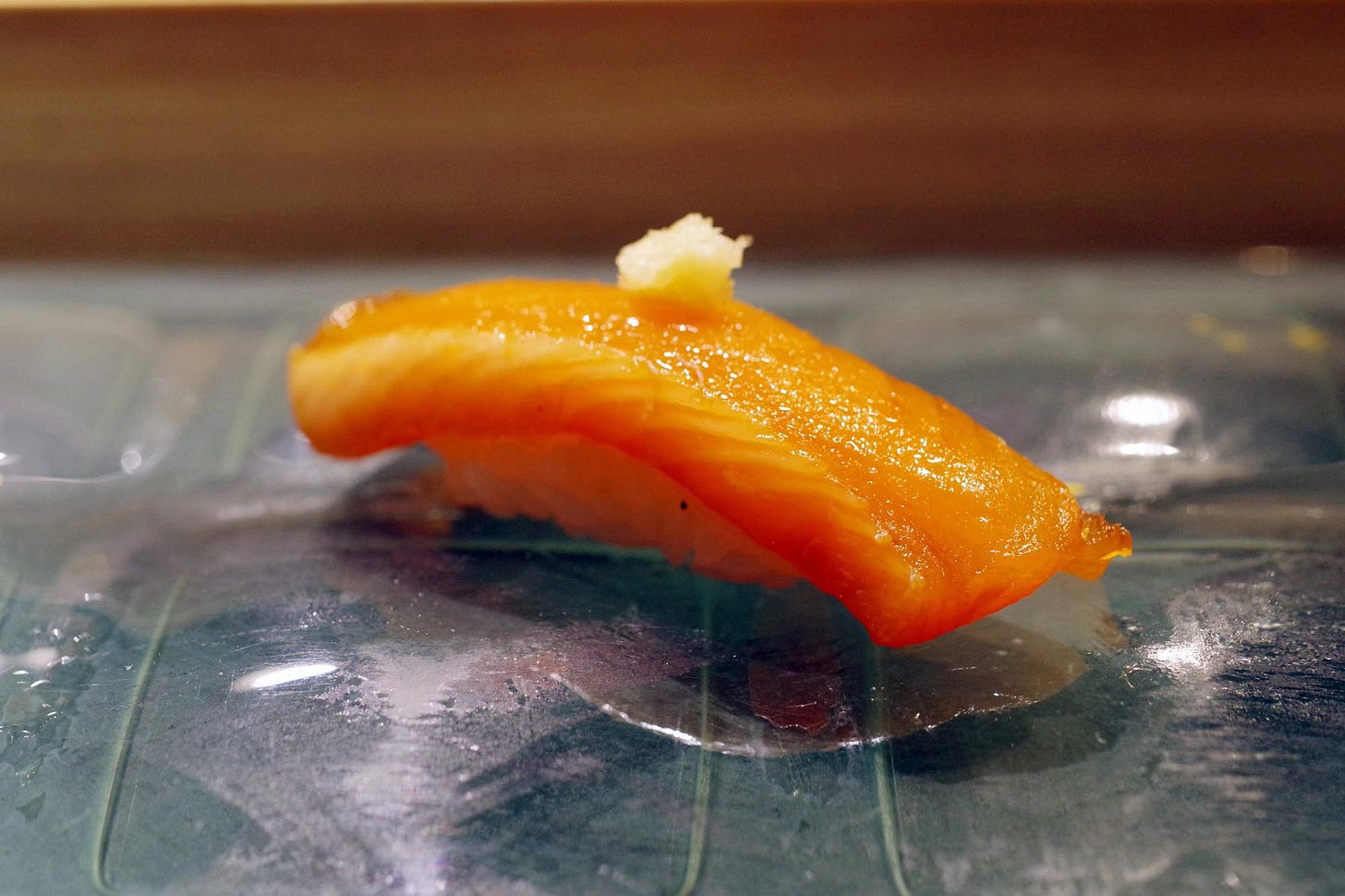In this first installment covering "Traditional Sushi Types," we'll discuss the following five varieties of whitefish toppings:
Flounder (Hirame)
Flathead Flounder (Makogarei)
Trout (Masu)
Flounder (Hirame)
Japanese Name: Hirame
English Name: Flounder
Sushi Topping Category: Whitefish
Main Seasonal Period: Winter
Along with sea bream, flounder (also known as sole) is a high-end fish familiar to all Japanese diners. Due to its delicate aroma and flavor, those who can discern the nuances between good and bad flounder have a refined palate. People accustomed to fast food or meals with strong artificial seasonings may struggle to appreciate this fish's subtle qualities. As far as Edomae-zushi, flounder reaches its peak in winter, and savoring a delicious flounder epitomizes the pleasure of eating sushi during the colder months. The top-grade flounder served at the finest sushi restaurants is exceptionally flavorful and rich, with a translucent white flesh imbued with a golden hue.
When savoring flounder at a sushi restaurant, pay attention to these key aspects:
Aroma
Taste
Texture
Flavor balance with the rice
Thickness of the cut to achieve the above qualities
Aroma is the most critical characteristic of any whitefish, not just flounder. A delicate fragrance reveals the unique qualities of each fish. Even if the taste improves with age, a flounder loses its appeal if the aroma and texture deteriorate. Furthermore, no matter how exquisite the flounder, if the rice's flavor overpowers the fish, the harmony is lost. Specifically, rice with excessive acidity or saltiness that overwhelms the flounder's delicate taste fails to complement the fish properly.
Flathead Flounder (Mako-garei)
Japanese Name: Mako-garei
English Name: Flathead Flounder
Sushi Topping Category: Whitefish
Main Seasonal Period: Summer
When Mako-garei (flathead flounder) appears on sushi menus, it signifies a change in the air. Its arrival brings the fresh, green scent of early summer. While it hints at the coming heat, the milder temperatures allow the fish's refreshing taste to shine. Its taste is lighter than the wintertime flounder, but that makes the rice a little more acidic, imparting a refreshing summer flavor. Mako-garei is also cherished in the Kansai and Setouchi regions, where it's known as "amate-garei." In Kyushu, mako- garei sourced from Hiji town in Oita Prefecture is branded as "shiroshita-garei" and prized for its exceptional quality.
When savoring flathead flounder at a sushi restaurant, pay attention to these key aspects:
Aroma
Taste
Texture
Flavor balance with the rice
Thickness of the cut to achieve the above qualities
The key points to savor when enjoying flathead flounder are similar to those for regular flounder.
Trout (Masu)
Japanese Name: Masu
English Name: Trout
Sushi Topping Category: Whitefish
Main Seasonal Period: Spring, year-round for farmed fish
Many people consider trout a modern addition to sushi menus, but it's actually a traditional ingredient. It's even used in Kansai-style oshizushi (pressed sushi). The most famous variety is "sakura-masu" (cherry blossom trout), served from March to April. This fish is especially popular because it swims upriver during the cherry blossom season and can be caught in abundance. The beautiful salmon-pink color of the flesh also contributes to its popularity as a springtime delicacy.
However, in sushi classification, trout is considered a "whitefish." You might wonder, "Isn't it a red-fleshed fish?" The answer lies in the type of trout. Rainbow trout and iwana (Japanese char), typically caught in mountain streams and measuring about 20 cm in length, have white flesh. On the other hand, salmon trout are anadromous, meaning they change habitats from freshwater to seawater and back to freshwater throughout their life cycle. They develop a reddish color by feeding on crustaceans in the ocean, which contain a natural pigment called astaxanthin (found in shrimp and crabs). In essence, trout is a fascinating fish that undergoes dramatic changes in body color based on its diet.
When savoring trout at a sushi restaurant, pay attention to these key aspects:
Aroma
Fat content
Tenderness
Seasoning
Trout has a remarkably robust flavor for a whitefish, with an aroma that sets it apart from other fish in this category. It also tends to be fatty, offering a pleasure similar to that of red-fleshed fish. However, due to its strong natural flavor, it's crucial that the sushi chef seasons the trout appropriately. It's advisable to avoid overpowering the fish's taste with excessively strong soy sauce or using seasonings and condiments with intense pungency or flavor. Such heavy-handed additions are techniques even an elementary school student could employ, so if a professional chef resorts to them, it may indicate a lack of taste and finesse.
That's all for now. I look forward to seeing you again! If you want to remember sushi toppings and fish varieties discussed in this chapter, please refer to this linked article.
I hope you're looking forward to my next article!
If you enjoy this article, please share it on your social networks. Your support inspires me to keep writing!
The TOC of “Spirits of Sushi“
The History of Sushi
Exploring Sushi Varieties: Edomae-zushi (Nigiri-zushi), Kansai-zushi, and More
Essential Sushi Vocabulary: Key Terms for Navigating a Sushi Restaurant
The Heart of Sushi: A Guide to “Shari”, Sushi Rice
A Deep Dive into Sushi Fish and Accompaniments
The Art of the Sushi Master: Traditional Japanese Knives
Japan's Exquisite Fish Culture: From Tsukiji to Toyosu Market and Various Regions
Must-Visit Sushi Restaurants: From Tokyo to Sapporo, Fukuoka, and Other Regions
Regional Sushi Styles: Exploring Japan's Diverse Sushi Culture
Sushi and Sake Pairings: A Culinary Adventure
Sushi Etiquette and Table Manner: Dining like a Sophisticated Local
Shopping in Japan: Essentials for Crafting Delicious Sushi at Home
Sushi in Pop Culture: Manga and Movies
Sushi: A Lens on Health and Sustainability
Wrapping Up: The Future of Sushi





